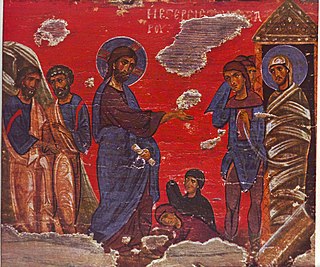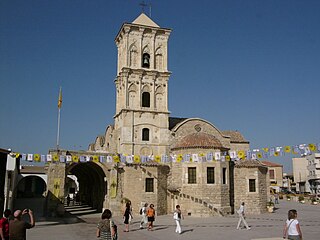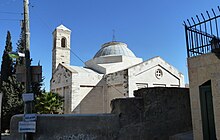
The Church of the Holy Sepulchre, also known as the Church of the Resurrection, is a fourth-century church in the Christian Quarter of the Old City of Jerusalem. The church is also the seat of the Greek Orthodox Patriarchate of Jerusalem. Some consider it the holiest site in Christianity and it has been an important pilgrimage site for Christians since the fourth century.

Mary of Bethany is a biblical figure mentioned by name in the Gospel of John and probably the Gospel of Luke in the Christian New Testament. Together with her siblings Lazarus and Martha, she is described as living in the village of Bethany, a small village in Judaea to the south of the Mount of Olives near Jerusalem.

Martha is a biblical figure described in the Gospels of Luke and John. Together with her siblings Lazarus and Mary of Bethany, she is described as living in the village of Bethany near Jerusalem and witnessing Jesus resurrecting her brother, Lazarus.

The Church of All Nations, also known as the Church of Gethsemane or the Basilica of the Agony, is a Catholic church located on the Mount of Olives in East Jerusalem, next to the Garden of Gethsemane. It enshrines a section of bedrock where Jesus is said to have prayed before his arrest.

Dominus Flevit is a Roman Catholic church on the Mount of Olives, opposite the walls of the Old City of Jerusalem in Israel. During construction of the sanctuary, archaeologists uncovered artifacts dating back to the Canaanite period, as well as tombs from the Second Temple and Byzantine eras.

The Via Dolorosa is a processional route in the Old City of Jerusalem. It represents the path that Jesus took, forced by the Roman soldiers, on the way to his crucifixion. The winding route from the former Antonia Fortress to the Church of the Holy Sepulchre—a distance of about 600 metres (2,000 ft)—is a celebrated place of Christian pilgrimage. The current route has been established since the 18th century, replacing various earlier versions. It is today marked by 14 Stations of the Cross, nine of which are outside, in the streets, with the remaining five stations being currently inside the Church of the Holy Sepulchre.

Lazarus of Bethany is a figure within the Christian Bible, mentioned in the New Testament in the Gospel of John, whose life is restored by Jesus four days after his death. This is seen by Christians as one of the miracles of Jesus. In the Eastern Orthodox Church, Lazarus is venerated as Righteous Lazarus, the Four-Days Dead. The Eastern Orthodox and Catholic traditions offer varying accounts of the later events of his life.

The Church of the Annunciation, sometimes also referred to as the Basilica of the Annunciation, is a Catholic church in Nazareth, in northern Israel. It is one of two claimants to the site of the Annunciation – in which angel Gabriel appeared to the Virgin Mary and announced that she would give birth to Jesus – the other being the Greek Orthodox Church of the Annunciation.

The Church of the Beatitudes is a Roman Catholic church located on the Mount of Beatitudes by the Sea of Galilee near Tabgha and Capernaum in Israel.

Bethany, locally called in Arabic Al-Eizariya or al-Aizariya, is a Palestinian town in the Jerusalem Governorate of Palestine, bordering East Jerusalem, in the West Bank. The name al-Eizariya refers to the New Testament figure Lazarus of Bethany, who according to the Gospel of John, was raised from the dead by Jesus in the town. The traditional site of the miracle, the Tomb of Lazarus, in the city is a place of pilgrimage.

The Church of the Flagellation is a Roman Catholic church and Christian pilgrimage site located in the Muslim Quarter of the Old City of Jerusalem, near St. Stephen's Gate. It is part a Franciscan monastery which also includes the Church of the Condemnation and Imposition of the Cross. The monastery stands at the traditional Second Station of the Cross on the Via Dolorosa.

The Tomb of Lazarus is a traditional Christian pilgrimage in the al-Eizariya suburb of Jerusalem Governorate, Palestine. It is located on the southeast slope of the Mount of Olives, some 2.4 km east of the city limits of Jerusalem. The tomb is the purported site of a miracle recorded in the Gospel of John in which Jesus raised Lazarus from the dead.

The Church of the Transfiguration is a Franciscan church located on Mount Tabor in Israel. It is traditionally believed to be the site where the Transfiguration of Jesus took place, an event in the Gospels in which Jesus is transfigured upon an unnamed mountain and speaks with Moses and Elijah.

The Church of Saint Lazarus is a late-9th century church in Larnaca, Cyprus. It belongs to the Church of Cyprus, an autocephalous Greek Orthodox Church.

Antonio Barluzzi was an Italian architect who became known as the "Architect of the Holy Land" by creating, among many others, the pilgrimage churches at the Garden of Gethsemane, on Mount Tabor, on the Mount of Beatitudes, and at the tomb of Lazarus in Bethany. He also restored, giving them a new outlook, several churches and chapels including the Catholic chapel on Calvary, within the Church of the Holy Sepulchre. Most of his work was done on commission for the Franciscan Custody of the Holy Land, with whom he was affiliated as a layman rather than as a professed member.

The Shepherds' Field Chapel, or the Sanctuary of Gloria in excelsis Deo, is a Roman Catholic religious building in Beit Sahour, southeast of Bethlehem, West Bank, Palestine. The chapel commemorates the annunciation of Jesus' birth to the shepherds, said to have taken place in Beit Sahour.
Auspicius of Apt also known as Auspice of Apt (96–102), was a Pre-Congregational saint, first bishop of Apt, France who was consecrated by Clement I and martyred under Trajan.
St. Lazarus' Church may also refer to:


















